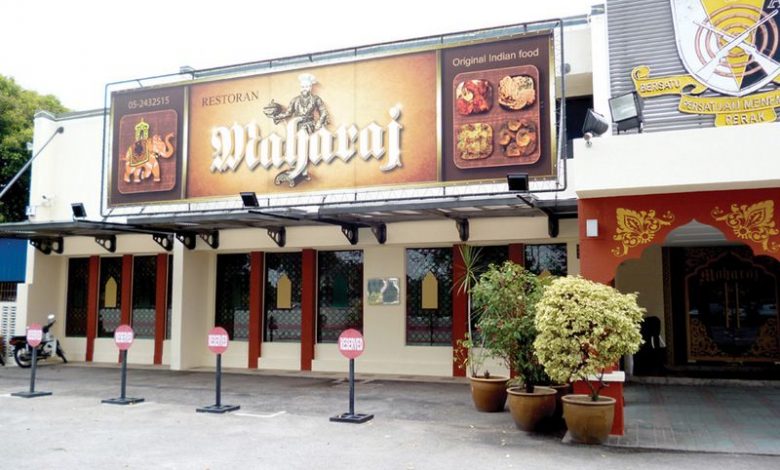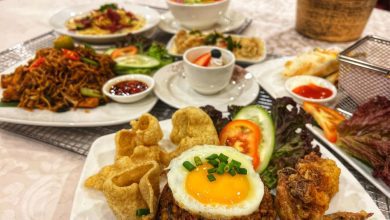

No, I haven’t had a sex change but as the name Maharaj implies, this restaurant serves cuisine fit for a king. And the interior decor is equally befitting of royalty. Exuberant murals adorn the walls with scenes of the glorious days of the Raj and Moghul times; stunning chandeliers and other light fixtures brighten rooms; crenellated Corbel arches open up the space between tables; two private rooms, one seating twenty and the other twelve and an impressive grand function room accommodating 150 for sit down banquets, create an ambiance that can only be described as lavish. Ample parking space in this Gopeng Road location, a converted bungalow that is part of the Shooting Club, completes the appeal of this newly-opened venue for dinner, lunch or banquets.


A meal here at Maharaj can be likened to a gourmet feast around India as they’re proud to be presenting dishes from the different states such as Andhra Pradesh, Kerala, Tamil Nadu, the West Coast and Northern India.
I was watching an interesting programme on TV when host Alton Brown was explaining that there is no such thing as curry powder (a term coined in the west for that mix of spices) in India. Each dish, of what we call ‘curry’, is an intricate combination of herbs and spices used either as a dry powder or in the form of a paste, each one a different blend and called the masala. It is this masala, with each state having its preferences, which gives each dish its unique flavours. Just as we have our different types of ‘rempah’ Indians have different ‘masala’.
The menu at Maharaj is staggering. Just the fact that they have 100 different kinds of kebabs available, although only eight of them are listed on their menu, suggests the range of possibilities at this restaurant. Those familiar with Indian cuisine are always welcome to discuss with the manager, Murugan, for any dishes they may hanker for. As it is, the range of dishes I tasted on two occasions left me groaning with surfeit and toying with the idea of fasting for a week! The saving grace though is that the restaurant does not use MSG (remember my war on MSG in IE 192?) and I did not have to go through the swelling and the thirst that invariably follow my reaction to this ubiquitous flavour enhancer.
Space on this page will limit me in describing all of the dishes I tasted. I will only list here the specials that were, in my opinion, superb and incent me to return to sample more. For appetizers we had two dishes that were as delicious as they were unusual in that I had never encountered them prepared this way before. The first was a Bendhi Jaipuri, sliced ladies fingers coated with batter and sesame seeds and deep fried and the second was the Palak Pakoda or deep fried spinach – RM6.
As in most Indian meals, we began with the Tandoori Chicken, this one succulent, juicy, lightly charred and utterly delectable; unlike others I’ve tried which can be dry and not flavourful. Proprietor Thangaraja tells his chef to not stint on ingredients and hence they only use fresh and not frozen meat. This also applies to their mutton which is freshly slaughtered and supplied twice a week. The mixed kebab dish that followed was almost a meal in itself comprising fish with mint and yoghurt, a mutton kebab, prawns and chicken. Served with their coriander, mint chutney, every mouthful is worth savouring. Total the number of kebabs ordered from the menu RM16-18 per type of kebab. An average taster platter for five people might be RM58.


For mutton, try the Mutton Chettinad, a specialty from Tamil Nadu, mildly spiced, with a thick sauce, the mutton tender and flavourful – RM18. Malabar Fish Curry was tenggiri (local mackerel) centre cuts cooked in a coriander flavoured sauce with coconut milk; mild and rich – RM16. Another fish dish that is a ‘must-have’ is the Black Pomfret Masala, a dark, intense masala sauce enveloping a whole market-fresh pomfret with intense fiery undertones. Seasonal price. The one we had that day was RM28. As for other fish, I had the pleasure to sample two. One, the Tiger Prawn Masala, slit open, still in their shell, and grilled with a masala paste topping and served with lime wedges; sea-fresh and grilled to perfection; seasonal price. The other, Prawn Curry Leaves, medium-size prawns coated in a special masala and deep fried with curry leaves; crispy, mouth-wateringly good – RM18.


Chicken dishes abound on the Maharaj menu. The Komudi Kholapur is a dish from Maharashtra state which are chicken chunks with a thick gravy. The chicken was tender with a mild and smooth gravy – RM15.
Of course, no Indian meal can be eaten without the breads and rice. Six types of bread are available as well as a mini Naan basket – RM3-6 for the various types and RM18 for the mini mixed one. Of note are the specials, the Pulka which is like a chapati but much lighter and their paratha which as Murugan laughingly says as he served it, “…your Roti Canai”. And there the similarity ends. The Paratha here is extremely flaky, crisped on both sides and delicious – RM4.50.


As for the rice, the Dhum Bryani is the best I’ve ever tasted, and for the rest of my group as well.
The method of cooking is what gives this its signature taste and flavour, with the rice and all ingredients sealed inside a pot using a flour dough to seal the lid, and slow cooked over low heat till the rice is done. The result in the Maharaj is an ambrosia of flavours, each grain of basmati rice, well coated in the masala, pieces of tender mutton lending its umami signature to the whole dish – RM16.
All in all, Maharaj Restaurant is well worth patronising. My friend Saroja Tiagi summed it up very well when she said, “I could eat here every day and not exhaust the menu. Plus I don’t feel bloated and have heart burn afterwards.” A good testimony indeed.




